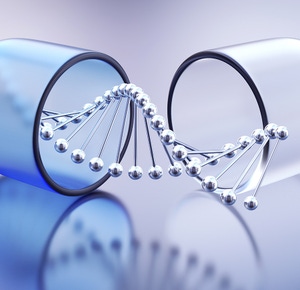

AlphaLISA SureFire Ultra Human Total PAX5 Detection Kit, 50,000 Assay Points
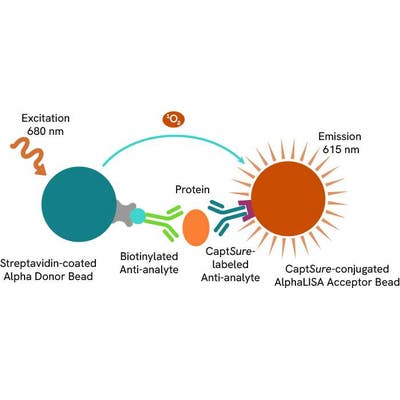

AlphaLISA SureFire Ultra Human Total PAX5 Detection Kit, 50,000 Assay Points
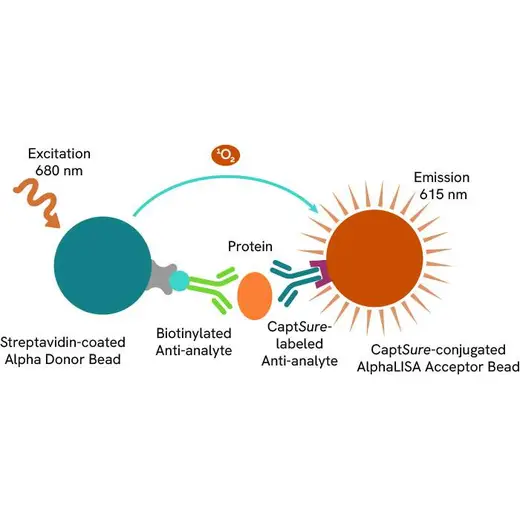


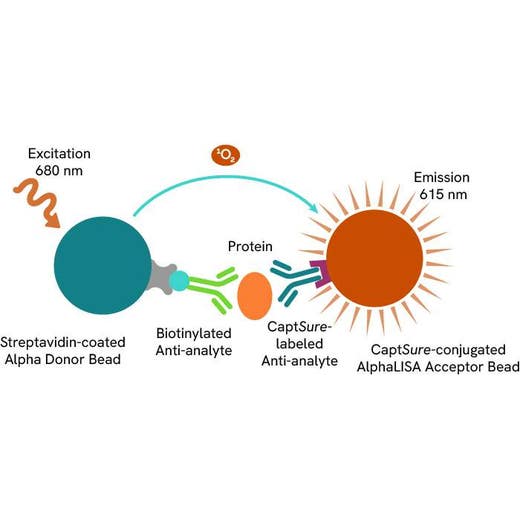


The AlphaLISA™ SureFire® Ultra™ Human Total PAX5 assay is a sandwich immunoassay for quantitative detection of total PAX5 in cellular lysates using Alpha Technology.
| Feature | Specification |
|---|---|
| Application | Cell Signaling |
| Protocol Time | 2h at RT |
The AlphaLISA™ SureFire® Ultra™ Human Total PAX5 assay is a sandwich immunoassay for quantitative detection of total PAX5 in cellular lysates using Alpha Technology.



AlphaLISA SureFire Ultra Human Total PAX5 Detection Kit, 50,000 Assay Points



AlphaLISA SureFire Ultra Human Total PAX5 Detection Kit, 50,000 Assay Points



Product information
Overview
PAX5 is a transcription factor crucial for B-cell development, regulating genes specific to B-cell identity. It interacts with transcription factors like EBF1 and RUNX1 to control gene expression during B-cell differentiation. Alterations in PAX5, including mutations and translocations, are implicated in B-cell acute lymphoblastic leukemia and non-Hodgkin lymphoma, disrupting normal B-cell function and driving malignancy.
The AlphaLISA SureFire Ultra Human Total PAX5 Detection Kit is a sandwich immunoassay for the quantitative detection of total PAX5 in cellular lysates, using Alpha Technology.
Formats:
- The HV (high volume) kit contains reagents to run 100 wells in 96-well format, using a 60 μL reaction volume.
- The 500-point kit contains enough reagents to run 500 wells in 384-well format, using a 20 μL reaction volume.
- The 10,000-point kit contains enough reagents to run 10,000 wells in 384-well format, using a 20 μL reaction volume.
- The 50,000-point kit contains enough reagents to run 50,000 wells in 384-well format, using a 20 μL reaction volume.
AlphaLISA SureFire Ultra kits are compatible with:
- Cell and tissue lysates
- Antibody modulators
- Biotherapeutic antibodies
AlphaLISA SureFire Ultra kits can be used for:
- Cellular kinase assays
- Receptor activation studies
- High-throughput screening for preclinical studies
Specifications
| Application |
Cell Signaling
|
|---|---|
| Automation Compatible |
Yes
|
| Brand |
AlphaLISA SureFire Ultra
|
| Detection Modality |
Alpha
|
| Protocol Time |
2h at RT
|
| Shipping Conditions |
Shipped in Blue Ice
|
| Target |
PAX5
|
| Target Class |
Phosphoproteins
|
| Target Species |
Human
|
| Technology |
Alpha
|
| Therapeutic Area |
Oncology
|
| Unit Size |
50,000 assay points
|
Video gallery

AlphaLISA SureFire Ultra Human Total PAX5 Detection Kit, 50,000 Assay Points

AlphaLISA SureFire Ultra Human Total PAX5 Detection Kit, 50,000 Assay Points

How it works
Total-AlphaLISA SureFire Ultra assay principle
The Total-AlphaLISA SureFire Ultra assay measures the expression level of a protein target in a cell lysate.
The Total-AlphaLISA SureFire Ultra assay uses two antibodies which recognize two different distal epitopes on the targeted protein. AlphaLISA assays require two bead types: Acceptor and Donor beads. Acceptor beads are coated with a proprietary CaptSure™ agent to specifically immobilize the assay specific antibody, labeled with a CaptSure tag. Donor beads are coated with streptavidin to capture one of the detection antibodies, which is biotinylated. In the presence of targeted protein, the two antibodies bring the Donor and Acceptor beads in close proximity whereby the singlet oxygen transfers energy to excite the Acceptor bead, allowing the generation of a luminescent Alpha signal. The amount of light emission is directly proportional to the quantity of protein present in the sample.

Total-AlphaLISA SureFire Ultra two-plate assay protocol
The two-plate protocol involves culturing and treating the cells in a 96-well plate before lysis, then transferring lysates into a 384-well OptiPlate™ plate before the addition of Total-AlphaLISA SureFire Ultra detection reagents. This protocol permits the cells' viability and confluence to be monitored. In addition, lysates from a single well can be used to measure multiple targets.
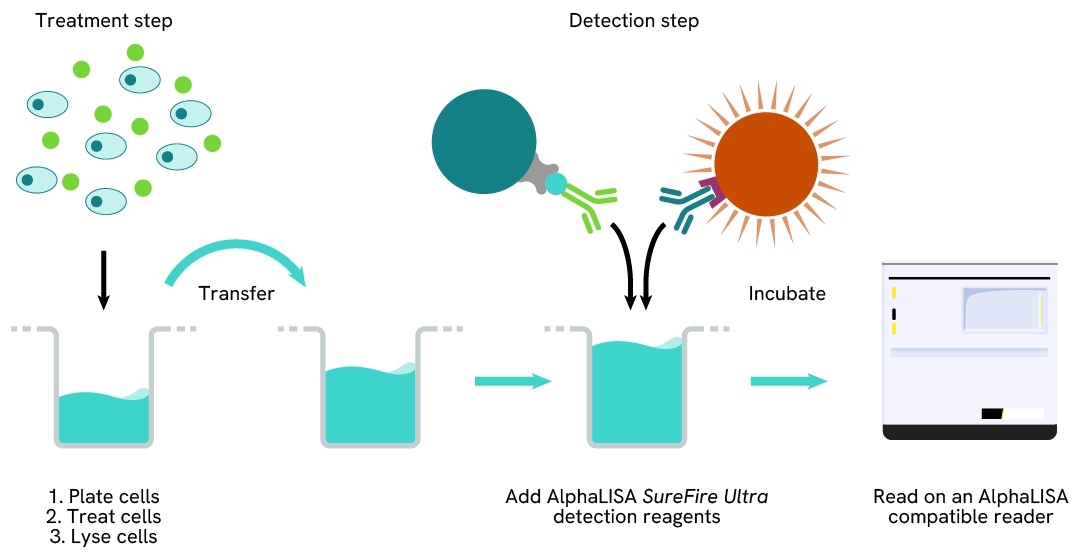
Total-AlphaLISA SureFire Ultra one-plate assay protocol
Detection of Total target protein with AlphaLISA SureFire Ultra reagents can be performed in a single plate used for culturing, treatment, and lysis. No washing steps are required. This HTS designed protocol allows for miniaturization while maintaining AlphaLISA SureFire Ultra quality.
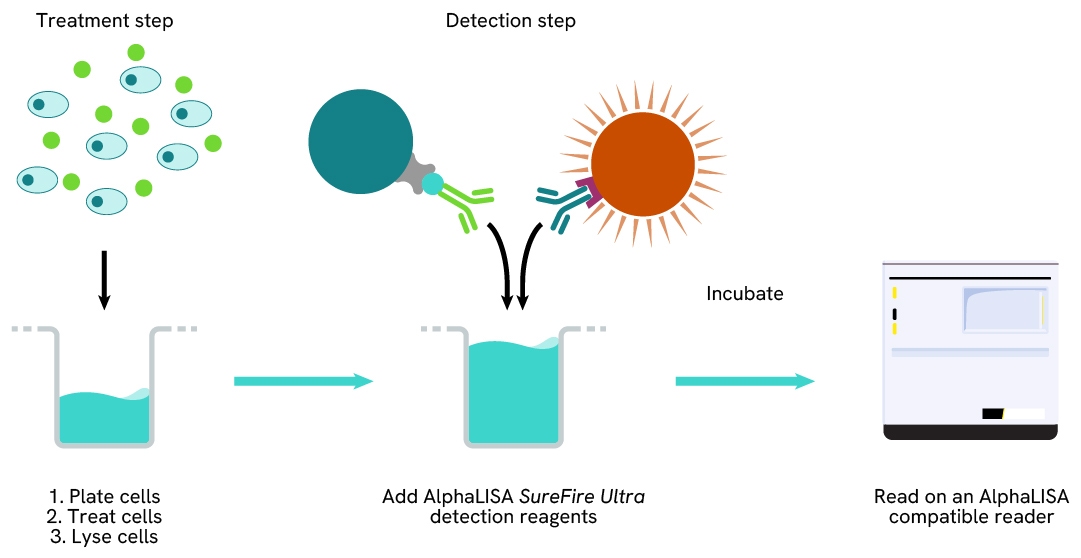
Assay validation
Specificity of PAX5 Total assay
Specificity of the Total PAX5 assay was assessed by assaying recombinant PAX2 and PAX5 proteins. Dilutions of recombinant PAX2 and PAX5 proteins were prepared in Lysis Buffer. PAX5 Total levels were evaluated using the AlphaLISA SureFire Ultra assay. For the detection step, 10 µL of protein was transferred into a 384-well white OptiPlate, followed by 5 µL of Acceptor mix and incubated for 1 hour at room temperature. Finally, 5 µL of Donor mix was then added to each well and incubated for 1 hour at RT in the dark. The plate was read on an Envision using standard AlphaLISA settings.
Total PAX5 assay was specific only to PAX5 recombinant protein, no signal was detected with PAX2 recombinant protein. This result demonstrates the specificity of the Total PAX5 SureFire Ultra assay as these two proteins share approximately 70% sequence identity.
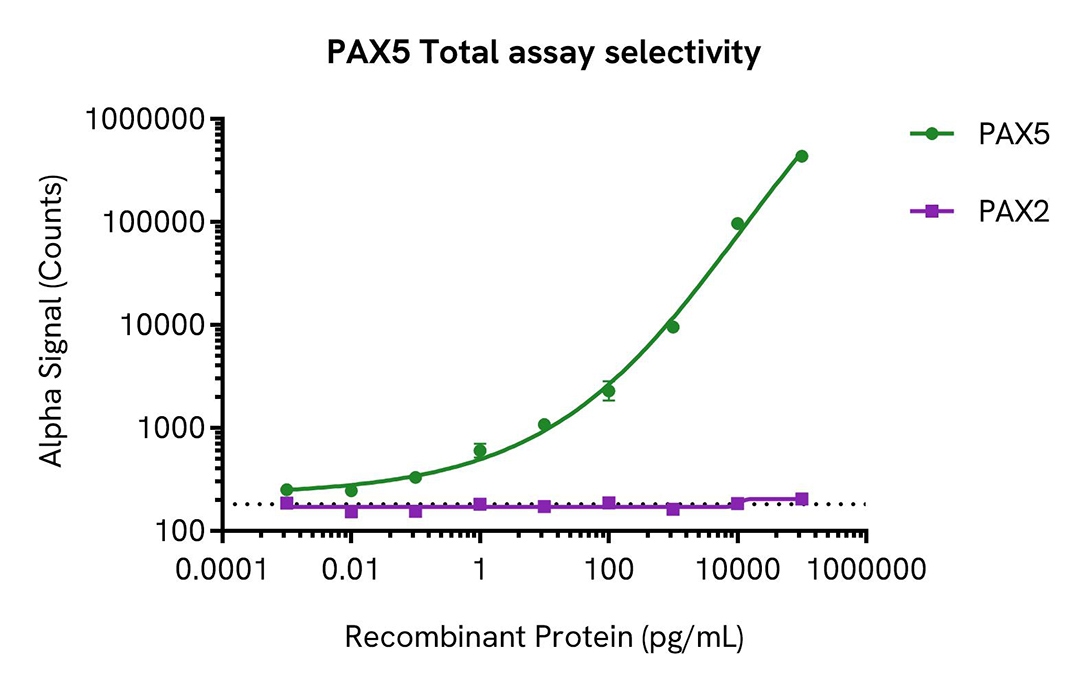
Validation of PAX5 Total assay in various cell lines
Adherent cells were seeded at 40,000 cells/well in a 96-well culture plate in complete medium and incubated overnight at 37°C, 5% CO2. Cells were lysed with 100 µL of Lysis Buffer.
Suspension cells (Daudi, RAMOS) were seeded at 100,000 cells/well (200 µL/well) in a 96-well culture plate in HBSS + 0.1% BSA, cells were spun down and lysed with 100 µL of Lysis Buffer. Suspension cell lysates were further diluted 1:2.5 with Lysis Buffer.
PAX5 Total levels were evaluated by AlphaLISA SureFire Ultra. For the detection step, 10 µL of cell lysate (approximately 4,000 cells) was transferred into a 384-well white OptiPlate, followed by 5 µL of Acceptor Mix and incubated for 1 hour at RT. Finally, 5 µL of Donor Mix was then added to each well and incubated for 1 hour at RT in the dark. The plate was read on an Envision using standard AlphaLISA settings.
Total PAX5 expression is dependent upon cell type. As expected, a very high level of expression was detected in Daudi and Ramos cells, while signal was undetectable in OVCAR-3, AN3 CA, PANC-1 cells.

Resources
Are you looking for resources, click on the resource type to explore further.
The definitive guide for setting up a successful AlphaLISA SureFire Ultra assay
Several biological processes are regulated by...
Discover Alpha SureFire® Ultra™ assays, the no-wash cellular kinase assays leveraging Revvity's exclusive bead-based technology...
This document includes detailed tables listing HTRF™, AlphaLISA™ SureFire® Ultra™, and Alpha SureFire® Ultra™ Multiplex assays...
Loading...


How can we help you?
We are here to answer your questions.





